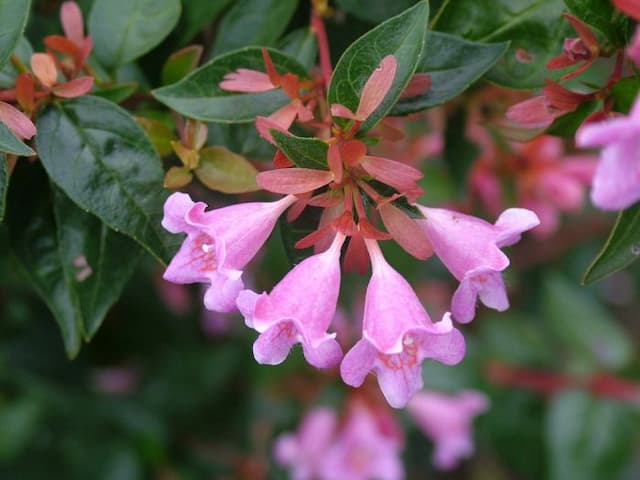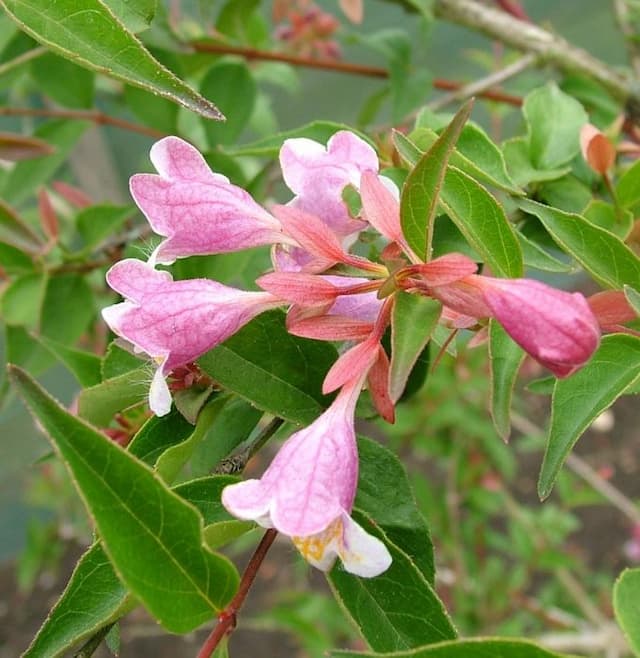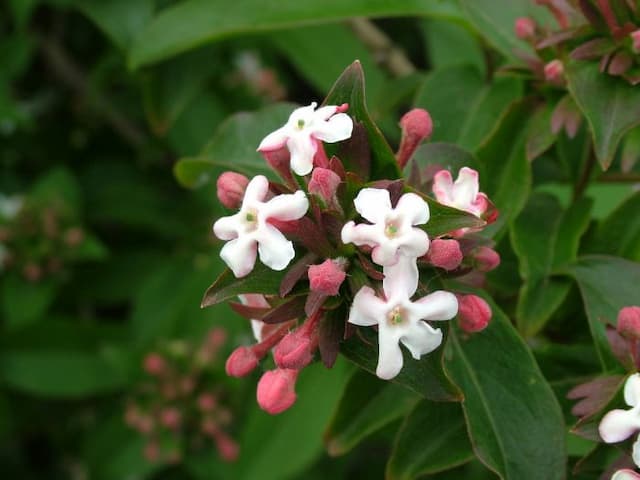Japanese Honeysuckle Lonicera japonica var. repens

ABOUT
Lonicera japonica var. repens, commonly known as Japanese Honeysuckle, is a vining plant renowned for its attractive and fragrant flowers. Its stems are long and somewhat woody, often twining around structures or other plants for support, giving it a climbing habit. The leaves of Japanese Honeysuckle are oval in shape, have a lush green hue, and are paired opposite each other on the stem. The most striking aspect of the plant is its trumpet-shaped flowers, which are typically about 1-2 inches long. The flowers of Japanese Honeysuckle are two-toned, with white and yellow being the predominant colors, and they possess a delicate, sweet scent that is particularly noticeable in the evening or at night. After flowering, the plant produces small black berries that are popular with wildlife but should not be consumed by humans as they can be toxic. The contrast between the foliage and the flowers can be quite stunning, making Japanese Honeysuckle a popular choice for ornamental gardens where it can provide year-round interest.
About this plant
 Names
NamesFamily
Caprifoliaceae.
Synonyms
Japanese Honeysuckle, Hall's Honeysuckle, White And Yellow Honeysuckle, Chinese Honeysuckle.
Common names
Lonicera japonica Thunb., Nintooa japonica (Thunb.) Sweet.
 Toxicity
ToxicityTo humans
Japanese Honeysuckle is generally considered to have some degree of toxicity if ingested by humans. The berries and possibly other parts of the plant contain saponins and cyanogenic glycosides which can cause gastrointestinal problems if consumed in large quantities. Symptoms of poisoning may include nausea, vomiting, diarrhea, and stomach pain. Rarely, more serious symptoms could occur, such as difficulty breathing or increased heart rate, but this is generally associated with consuming large quantities of the plant material.
To pets
Japanese Honeysuckle may also pose a risk to pets if consumed. The berries, leaves, and stems contain components that can be harmful, such as saponins and cyanogenic glycosides. Symptoms of poisoning in pets might include vomiting, diarrhea, loss of appetite, and lethargy. In severe cases, ingestion can lead to more serious symptoms, including difficulty breathing, dilated pupils, or increased heart rate. It is important to prevent pets from ingesting parts of this plant.
 Characteristics
CharacteristicsLife cycle
Perennials
Foliage type
Deciduous
Color of leaves
Varies
Flower color
White
Height
10 feet (3 meters)
Spread
30 feet (9 meters)
Plant type
Climber
Hardiness zones
4
Native area
Japan
Benefits
 General Benefits
General Benefits- Ornamental Value: Lonicera japonica var. repens, commonly known as Japanese Honeysuckle, is widely appreciated for its fragrant white to yellow flowers, which can add beauty to gardens and landscapes.
- Wildlife Attraction: The plant is a source of nectar for hummingbirds and butterflies, helping to support biodiversity by attracting these pollinators.
- Erosion Control: Its vigorous growth and rooting ability can help stabilize soil on slopes, preventing soil erosion in certain landscapes.
- Shade Tolerance: Japanese Honeysuckle can grow well in partial shade, making it versatile for different garden aspects where other plants may not thrive.
- Growth Habit: With its twining vines, it can cover unsightly areas or structures like fences and walls, providing a natural green aesthetic.
- Fragrance: The sweet-smelling blooms can enhance the sensual experience of a garden, making outdoor spaces more inviting.
- Drought Resistance: Once established, it is quite tolerant of drought, reducing the need for frequent watering.
- Rapid Coverage: For areas needing quick coverage, Lonicera japonica var. repens grows fast, providing greenery or flowering vines in a relatively short period.
- Seasonal Interest: It provides year-round interest with its persistent foliage in warm climates, and blooms primarily in spring and summer.
 Medical Properties
Medical Properties- Antibacterial: Lonicera japonica, commonly known as Japanese Honeysuckle, has been cited for its antibacterial properties against various bacteria.
- Anti-inflammatory: The plant contains compounds that have been reported to reduce inflammation.
- Antiviral: Extracts of the plant have shown activity against certain viruses, particularly in traditional East Asian medicine.
- Antioxidant: Japanese Honeysuckle contains antioxidants which help in preventing oxidative stress and may support overall health.
- Febrifuge: The plant has been used in herbal medicine to reduce fevers.
- Diuretic: It has been used traditionally to promote urine production and relieve fluid retention.
- Soothing agent: The plant's extracts are sometimes used for their soothing effects on the skin.
- Expectorant: In some medicinal traditions, it is used to clear respiratory passages.
 Air-purifying Qualities
Air-purifying QualitiesThis plant is not specifically known for air purifying qualities.
 Other Uses
Other Uses- Ground Cover: Japanese honeysuckle can be used as an aggressive ground cover, rapidly spreading to suppress weeds and prevent soil erosion.
- Livestock Forage: In some regions, it is used as forage for livestock such as goats, which can help control its spread.
- Bonsai: Enthusiasts may train Japanese honeysuckle to create bonsai arrangements due to its flexible stems and attractive flowers.
- Wildlife Habitat: The dense thickets provide shelter and nesting sites for various small birds and mammals.
- Perfume Industry: The sweet fragrance of Japanese honeysuckle flowers is used in the perfume industry to create scented products.
- Dye Production: The plant has been used traditionally to produce a dye for fabric, though it's not a common use.
- Garden Aesthetics: It is planted for its aesthetic appeal due to its cascading vines and profusion of flowers in ornamental gardens.
- Erosion Control on Slopes: Japanese honeysuckle's robust rooting system makes it suitable for stabilizing slopes and preventing landslides.
- Festive Garlands: Its vines and flowers can be made into garlands for decoration during festivals or events.
- Flower Arrangements: Fresh or dried flowers can be used in flower arrangements for their appearance and fragrance.
Interesting Facts
 Feng Shui
Feng ShuiJapanese Honeysuckle is not used in Feng Shui practice.
 Zodiac Sign Compitability
Zodiac Sign CompitabilityJapanese Honeysuckle is not used in astrology practice.
 Plant Symbolism
Plant Symbolism- Love: Japanese Honeysuckle, like many honeysuckle varieties, is often associated with love and affection, due to its entwining growth habit symbolizing closely held bonds.
- Devotion: The plant's tendency to cling and grow persistently is symbolic of devotion and loyalty.
- Fraternal Affection: The interlaced vines are reminiscent of human relationships and can represent the strong, intertwining connections between siblings or close friends.
- Generosity: With its abundant, sweet-smelling flowers, Japanese Honeysuckle is also a symbol of generosity and giving without expectation of return.
- Bonding: Whether it is the bond between lovers or friends, the vine holds on tightly to its support, much as people hold on to each other in a strong relationship.
 Water
WaterJapanese Honeysuckle (Lonicera japonica var. repens) prefers consistent moisture but does not do well with waterlogged soil, so it's essential to ensure good drainage. Water this plant once a week with about 1-2 gallons of water, increasing frequency to twice a week during extended periods of dry weather or high temperatures. In cooler months or when rainfall is abundant, you can reduce watering to every other week or less. Always check the top inch of soil for dryness before watering to avoid overwatering.
 Light
LightJapanese Honeysuckle thrives best in full sun to partial shade. For optimal growth, plant it in a location where it can receive at least 6 hours of direct sunlight each day. However, in regions with very hot summers, some afternoon shade can be beneficial to prevent stress from excessive heat.
 Temperature
TemperatureJapanese Honeysuckle is hardy and can withstand a range of temperatures; it typically does well in areas where temperatures range between 20 and 90 degrees Fahrenheit. This vine can survive minimal winter temperatures down to around 10 degrees Fahrenheit, but frost can damage young growth. The ideal temperature for vigorous growth falls between 70 and 85 degrees Fahrenheit.
 Pruning
PruningJapanese Honeysuckle should be pruned to control growth and spread, as it can become invasive. Pruning also promotes healthier plants by increasing air circulation, which reduces the risk of diseases. The best time to prune is in late winter or early spring before new growth starts. Prune as often as needed to maintain the desired shape and size, and to remove any dead or damaged branches.
 Cleaning
CleaningAs needed
 Soil
SoilJapanese Honeysuckle thrives best in a well-draining soil mix with a pH ranging from 5.5 to 7.5. A good recipe includes a mixture of equal parts loamy soil, peat moss, and perlite or coarse sand to enhance drainage and aeration, promoting healthy root growth. Mulch can be added to help retain moisture while avoiding waterlogging.
 Repotting
RepottingJapanese Honeysuckle should be repotted every two to three years to prevent the roots from becoming pot-bound and to replenish the nutrients in the soil. It is best to repot in the spring just before the growing season begins.
 Humidity & Misting
Humidity & MistingJapanese Honeysuckle prefers moderate to high humidity levels but can tolerate lower humidity conditions. It performs best when the surrounding humidity is around 60-70% but will adapt to average room humidity if kept well-watered and healthy.
 Suitable locations
Suitable locationsIndoor
Place in bright, indirect light and keep moist.
Outdoor
Plant in partial shade, water regularly, and mulch.
Hardiness zone
4-9 USDA
 Life cycle
Life cycleLonicera japonica var. repens, commonly known as Japanese Honeysuckle, begins its life as a seed, often germinating after a period of stratification, which is a cold treatment that mimics winter conditions. Upon germination, the seedling emerges and develops primary leaves, initiating the vegetative stage where rapid stem and leaf growth occurs, and the plant often starts to exhibit its characteristic twining habit. As the plant matures, it enters the flowering stage, usually in late spring to summer, producing fragrant, tubular flowers that range from white to yellow, attracting pollinators such as bees and hummingbirds. Following pollination, the flowers develop into small black berries, which are dispersed by animals, enabling seed dispersal for the continuation of the species. Throughout its life, Japanese Honeysuckle can spread vegetatively by sending out runners that root at the nodes, thereby colonizing new areas. This vigorous growth allows the plant to persist and often become invasive, surviving through various seasons until environmental conditions or management actions curtail its life cycle.
 Propogation
PropogationPropogation time
Spring-Early Summer
The most popular method for propagating Japanese Honeysuckle (Lonicera japonica var. repens) is through stem cuttings. This typically takes place during the growing season, which is spring through early summer. To propagate, take semi-hardwood cuttings of about 6 to 8 inches (15 to 20 centimeters) in length from a healthy parent plant. The cut end of the cutting should be dipped into rooting hormone to encourage root development and then planted in a well-draining soil mixture. Maintain adequate moisture and humidity levels by occasionally misting and covering the pot with a plastic bag or placing it in a greenhouse. Roots usually develop in a few weeks, after which the new plant can be gradually acclimated to outdoor conditions before planting in its final location.







![Himalayan honeysuckle [Golden Lanterns]](/_next/image?url=https%3A%2F%2Fplants-admin.emdemapps.com%2Fimages%2Fplants%2F%2Fimages%2F604b55302cc87.png&w=640&q=75)

